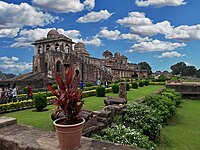
Photo from wikipedia
Abstract Ethnopharmacological relevance Ethnobotanical surveys are a key means of preserving indigenous knowledge of medicinal plants and their application within traditional medical systems. The present survey was undertaken within the… Click to show full abstract
Abstract Ethnopharmacological relevance Ethnobotanical surveys are a key means of preserving indigenous knowledge of medicinal plants and their application within traditional medical systems. The present survey was undertaken within the Jhabua district of Madhya Pradesh, India, to collect information from the Bhil and Bhilala tribes on the use of medicinal plants in the treatment of dermatological diseases. Material and methods The ethnobotanical data was collected from local traditional healers in 39 villages within the Jhabua district of western Madhya Pradesh, using standard ethnobotanical methods. The Use Value (UV), Fidelity Level (FL) and Informant Consensus Factor (ICF) were calculated in order to analyse the data collected and results were compared to prior ethnobotanical surveys relating to dermatological conditions conducted within India. Results A total of 116 plant species of 103 genera, belonging to 58 families were identified as used in the treatment of a total of 21 different dermatological disorders. UV ranged from Punica granatum, with the highest value of 2.41 to Rumex dentatus, with the lowest UV of 0.11. The highest FL of 100% was found for 17 plant species, and the ICF was found to range from 0.20 (leucoderma) to 1 (mouth ulcers). Conclusions The survey was able to identify and record the broad range of medicinal plants and practices used by the Bhil and Bhilala people in their treatment of dermatological conditions. The data collected is valuable, not only as part of the process of documenting and preserving a traditional knowledge and culture in danger of being lost, but also in its provision of a broad selection of medicinal plants that could be subjected to further pharmacological and clinical investigation for their potential role in the treatment of dermatological conditions.
Journal Title: Journal of Herbal Medicine
Year Published: 2020
Link to full text (if available)
Share on Social Media: Sign Up to like & get
recommendations!